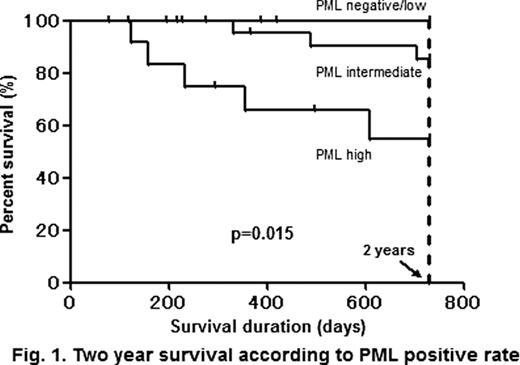Abstract
Abstract 2959
Although several novel agents have improved the prognosis of patients with multiple myeloma (MM), it still remains an incurable disease because of the difficulty to eradicate MM cells by current therapeutic approaches. Recent studies have revealed that a subset of malignant cells, cancer stem cells, contribute to chemotherapy-resistance in cancer treatment. Promyelocytic leukemia gene product (PML), known as a tumor suppressor through a variety of cellular functions in a nuclear macromolecular structure called the PML nuclear body, has been reported to be responsible for the chemotherapy-resistance by regulating cell cycle in chronic myeloid leukemia. We therefore investigated the impact of PML expression on the cellular proliferation status of MM cells and patients' prognoses.
Bone marrow clot sections from 48 patients with newly diagnosed MM from Jan 1998 to Dec 2009 before any therapy at diagnosis were obtained, and analyzed, according to appropriate procedure approved by IRB at the Tokai University School of Medicine (Kanagawa, Japan) with written informed consent. They were doubly-stained with a combination of anti-PML/anti-CD138 and anti-Ki67/anti-CD138. For evaluation of the relation between PML status and cellular proliferation, the positive rates of PML and Ki67 in CD138 positive cells were compared. For investigation of the impact of PML expression on the prognosis of MM, the patients were divided into 3 groups, according to the PML positive rates in the CD138 positive cells: negative/low (less than 25 percentile: 12 cases), intermediate (from 25 to 75 percentile: 24 cases) and high (more than 75 percentile: 12 cases). Their overall survivals were compared using log-rank test. Furthermore, the PML positive rates between before and after treatments were compared using paired t-test.
The median observation period of 48 cases was 915 days. The median age of the patients was 62.5 (38-76) at diagnosis. All the patients were underwent combination chemotherapies containing alkylating agents as initial therapies. Two and nine patients were underwent allogeneic and autologous stem cell transplantation during the clinical courses, respectively. The numbers of patients of international staging system (ISS) stage I, II and III were 17, 14 and 17 cases. The PML positive rates in each case ranged from 0% to 83.8%. They were not correlated with ISS stages (Spearman r = 0.083) and the Ki67 positive rates (Spearman r = -0.13). The PML positive rates in the negative/low, intermediate and the high groups were less than 22.1%, from 22.1 to 56.6% and more than 56.6%, respectively. No significant difference in overall survival was observed among the 3 groups (p>0.05). However, there were significant differences in two year survival rate when the 3 groups were compared (100%, 85.2% and 54.7%; p=0.015) (Fig. 1). In 13 patients whose bone marrow clot sections were sequentially collected, the PML positive rates after treatments were significantly higher than those at diagnosis (p=0.0042) (Fig. 2). Especially, PML positive rates in all the 3 patients from the negative/low group were progressively increased (0.3 to 82.6%, 14.1 to 100%, 19.0 to 37.5%), and 2 of them died due to disease progression. On the other hand, 2 patients whose PML positive rates decreased after treatment were alive more than 5 years without therapies.
Our data indicated that the level of the PML expression at diagnosis was a possible prognostic factor for early course of the disease (2 years after diagnosis). Chemotherapies might induce PML expression in MM cells or select PML positive MM cells. These findings suggest that PML expression presumably reflect chemotherapy-resistance in MM cells. The molecular mechanism of the association is now under investigation.
Two years survival according to PML positive rate
PML positive rates before and after treatment
No relevant conflicts of interest to declare.
Author notes
Asterisk with author names denotes non-ASH members.



This feature is available to Subscribers Only
Sign In or Create an Account Close Modal